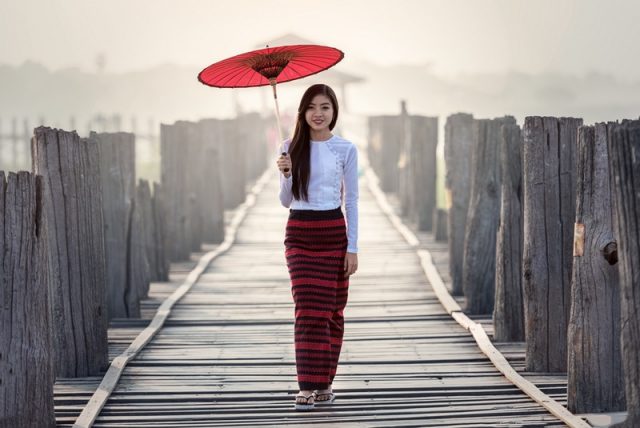Photographers don’t all see the world the same way, everyone is drawn to different aspects of life; whether the variety comes in the way subjects are interpreted or the way the subject is positioned.
While one photographer may be intrigued by the clear blue sky and the sunlight, another may be drawn to the magnificent birds and mammals.
Whether you are former or the latter or drawn to something else entirely, all that matters is that you recognize your art and are true to it. If you are wondering how to express your vision through photography, then this article is just what you need to read.
In this article, we will explore how photography can be used to express unique visions and showcase individuality. We’ll examine the different techniques and styles that photographers use to express themselves and highlight some of the ways in which photography can be a powerful medium for self-expression.
Developing Your Unique Vision

Photo by Depositphotos
Developing your unique vision involves finding inspiration, exploring different genres and styles, conveying your message, and practicing your craft. However, it’s not as easy as it sounds and can pose a significant challenge, especially if you are a beginner. Here are some tips for exploring your interests and influences to create a personal style:
- Take as many photos as you can
- Find your favorite genre
- Discover your favorite shooting conditions
- Consider your personality and values
- Try different camera operating systems
- Try various editing styles and software
- Discover your retouching and color-correcting preferences
- Work on and improve various skills such as your artistic, technical, communicative, and business skills.
- Avoid focusing solely on finding your style, you might stifle your creativity
Capturing Your Vision Through Composition

Photo by Depositphotos
It involves arranging the elements of your photo to convey an emotion or a message and guide the viewers to such a message. Various composition techniques, such as contrast, emphasis, movement, and eye gaze, can capture your vision as a photographer, tell a story, convey a feeling, and create visually compelling photos.
One way of capturing your vision in a photograph is with the mood and atmosphere portrayed. A good photographer knows how to create his image’s desired mood and atmosphere using compositions, thereby capturing his vision and style.
Below are some tips that you can employ to capture the desired mood or atmosphere in your photo using compositions:
- Create photos that are dynamic and balanced by using the rule of thirds
- Utilize leading lines to direct the viewer’s attention and establish direction
- Create harmony or tension by combining symmetry and asymmetries
- Create mood and emotion with color and contrast
Using Light and Vision to Enhance Your Vision

Photo by Depositphotos
Light and color are two important aspects of photography that can help you express your style and vision. Here are some ways you can use them effectively:
- Locate the light source and note its color, direction, intensity, and quality. Different types of light can produce various moods and effects in your photograph.
- When necessary, use a flash or a reflector to adjust the light. Diffusers, soft boxes, umbrellas, and other light modifiers can soften or shape light.
- Experiment with various lighting situations and angles to add contrast, shadows, highlights, and depth. You can also use multiple lighting configurations, such as three-point or broad and short lighting, to get various effects.
- Be familiar with the color wheel and color theory to design aesthetically pleasing color schemes. You can use complementary, analogous, triadic, or monochromatic hues to convey various effects and feelings in your photograph.
- Utilize white balance to modify the color temperature and remove any color casts in your photographs. Additionally, you can improve or alter the colors in your photos using filters or post-processing tools.
- These techniques will help you take advantage of the light and color elements of your photo to capture and enhance your vision in your photograph. A few successful photos use color and light to express a unique idea.
Examples include a stunning image by Steve McCurry that combines vibrant colors with various subjects to create an arresting image and a color image by Annie Leibovitz that contrasts warm colors with the chilly surroundings to convey a sense of intimacy and warmth.
Telling Your Story Through Photography

Photo by Depositphotos
Storytelling involves getting your viewers to catch the mood and atmosphere of the photo such that the viewers get the intended message. One photograph can convey various emotions, attitudes, ideas, and narratives to the viewer, making it a good tool for storytelling. If you’re looking to capture the attention of your viewers and move them to feel the mood and atmosphere of your photo, develop storytelling skills.
Photography storytelling is a skill that good photographers intentionally learn to deploy in their work. A good photographer can use this skill to express his unique style and vision by mixing the various elements of the photo to tell a story peculiar to his style and fiction. It takes a lot of practice to perfect the skill and tell beautiful stories with their photos, whether it’s just a single photo or a series of images.
The story you tell with your photograph depends on your passion, perspective, and purpose. Here are some considerations you might want to make in identifying a story to speak with your photo:
- Focus on subjects that relate to your passion, e.g., you can tell a story related to personal experience, interest, or curiosity.
- Search for inspiration in various places like other photographers’ works, books, magazines, documentaries, movies, music, etc.
- Plan by selecting a message and topic you plan to shoot. Also, think of the times, locations, etc., of the story you want to tell.
- Choose to capture emotions peculiar to your style and vision and place them at the core of your story.
Storytelling Photographers
Some examples of successful photographers and their storytelling techniques are
- Joel Robinson – He uses mixed media and post-processing to enhance his storytelling.
- Photographer and documentary filmmaker Dave Yoder tells tales of real-life situations, such as the fashion industry, the Vatican, and the wildlife of Africa. He illustrates various aspects of his narrative with multiple shots, angles, and details.
- Photographer Alice Alinari is known for her conceptual portraits that convey feelings, fantasies, and fears. She produces dramatic and expressive images through hues, accessories, costumes, and lighting.
Post-Processing and Your Unique Vision

Photo by Depositphotos
Just as it is used to add the final gloss to your photos and make them more striking, post-processing can also be used to enhance your vision as a photographer and add more clarity to the vision in your photos. Various techniques can be used to bolden your idea and its effects on the image. Here are guides for your development in photography:
- Use of contrast and saturation to make the photo clearer and more striking
- The use of curves and levels to adjust the brightness and tonality of your photos
- Use split toning to add color effects to your photos
- Use selective saturation to enhance colors in the photo
- Use exposure gradients to add depth and dimension to your photo
Read more about Photography Editing Tips.
Conclusion
Photography is not only a way of capturing reality but also a way of expressing one’s unique vision and style. Photographers use various elements and techniques to convey their messages and emotions through images. From choosing the subject, the composition, the lighting, and the angle to post-processing the photos, every decision reflects the photographer’s perspective and creativity.
By learning how to express their unique vision through photography, photographers can create more impactful and meaningful images that connect with their viewers. Therefore, if you seek to build a career in photography, you should develop a style and vision that you will center your work around and be recognized for.
Related Articles
Free Digital Photography Cheat Sheets
The Digital Photography Tips- Ultimate Q&A List
The Digital Photography Tips- Advanced Q&A
Featured Photo by Depositphotos
Thanks for reading, I hope you enjoyed the article, in case you have any questions just drop them below & I will be happy to answer you.
If you enjoy the site, don’t forget to subscribe, we will only inform you when a new article is posted.









Your article is very thought-provoking. It stirred up a long-forgotten, deep hidden desire I always had, to be able to capture a moment, something breath-taking I experienced, and portray it to others to share the same experience with me.
I never actually expressed this desire, or thought of pursuing it, until reading this article. The idea of giving expression to my ideas, experiences, my visions through photography, is something that never crossed my mind, until now. It must be that deep still call within, which brought me to read this specific article today.
I love your statement, “all that matters is that you recognize your art and are true to it”. This really struck a chord. I am very much interested in learning how to use imagery, specifically photography to better, or more strongly express certain ideas and visions I have, in a way that really impact people.
The topics you are covering here in this article, I found, have subtly started steering me to want to become more deliberate, more intentional about learning the art of photography. More specifically, how to take it to the level whereby I can, through storytelling photography, connect in a more meaningful, impactful way with people online.
Thank you for sharing all your insights in such a captivating way, especially in the part, “Telling your Story Through Photography”. This is exactly what I need for my venture into the digital marketing environment, where I will have to become more engaged with the online community. I think having this kind of knowledge about photography, on how to effectively create just the right kind of images through photography, can play a powerful role in successfully communicating ideas and experiences more effectively in online engagement with people.
Looking forward to following more of your articles to learn more in this regard 😊
Thank you for your kind words and for sharing your thoughts. I’m glad my article was able to inspire you to explore the world of photography and storytelling. Photography can be a powerful tool for expressing ideas and connecting with people, and I’m excited to hear that you’re interested in learning more about it. I hope my future articles can continue to provide insights and guidance as you embark on this journey.
This is a very inspiring article about vision. I am a strategist as well as an aspiring investor. Yes, what you have written is in Photography, but it can be applied to many other life areas.
The passion that is portrayed in your article is not only contagious but also illuminating.
Thank you for your kind words. Indeed, the concept of vision and developing a unique perspective can be applied to many areas of life, including investing and strategy. Passion and a clear vision are essential for success in any field, and I’m glad my article was able to inspire you.
I have read a lot of your articles and I am always amazed by how simple and at the same time how complex photography can be. It is exactly like what a painting is for a painter. Its unique expression on the canvas gives it its identity. I think the same applies for photography. Everyone can make good photos nowadays. But to have a unique and immediately recognizable style is what will set you apart from million other photographers.
Thank you for your kind words. Indeed, photography is both simple and complex, and developing a unique style is crucial for standing out in a crowded field. While technology has made it easier for anyone to take good photos, it’s the photographer’s individual perspective and vision that truly sets their work apart and gives it its identity.
As a photography enthusiast, I believe that a photographer’s vision plays a significant role in expressing uniqueness. Every photographer has their own perception of the world, and this reflects in their work. In my experience, looking at different photographers’ works has helped me understand the importance of having a unique vision and perspective. It’s fascinating how two photographers can capture the same subject matter differently because of their individual perspectives. This leads me to ask, “What advice do experienced photographers have for those struggling to find their unique voice and vision? How can one cultivate a distinctive style while still remaining true to oneself”?
Experienced photographers suggest that finding one’s unique voice and vision requires experimentation and exploration. It’s important to try different techniques, subjects, and styles to discover what resonates with you. Additionally, studying the works of other photographers can provide inspiration and help you identify what you like and dislike. However, it’s crucial to remain true to yourself and not try to emulate someone else’s style.
Ultimately, developing a distinctive style takes time and practice, but it’s worth the effort to create work that truly reflects your individual perspective.